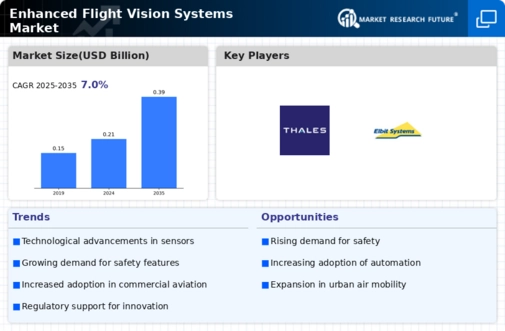Market Share
Enhanced Flight Vision Systems Market Share Analysis
In the rapidly advancing field of aviation, the Enhanced Flight Vision Systems (EFVS) market is witnessing strategic positioning strategies to secure a competitive edge. A notable trend in this market is the emphasis on technological innovation to enhance flight safety and operational capabilities. Companies investing in the research and development of cutting-edge EFVS technologies, such as infrared sensors and synthetic vision systems, position themselves as leaders in providing advanced solutions for enhanced visibility during adverse weather conditions and low-visibility scenarios. This focus on innovation not only addresses critical safety concerns but also positions EFVS providers as essential contributors to the modernization of aviation systems.
Strategic collaborations and partnerships are pivotal in market share positioning within the EFVS sector. EFVS technology providers often form alliances with aircraft manufacturers, avionics integrators, and regulatory authorities to foster the integration and certification of EFVS solutions. Collaborative efforts enable EFVS providers to align their technologies with industry standards, ensuring compliance with aviation regulations. Moreover, partnerships with key stakeholders facilitate the seamless integration of EFVS into new aircraft models and retrofitting solutions, strengthening the market position of EFVS technology providers.
Diversification of EFVS applications is a key strategy employed by market leaders. Recognizing the varied needs of different aviation segments, EFVS providers offer a diverse range of applications, including Head-Up Displays (HUDs), Head-Mounted Displays (HMDs), and Combined Vision Systems (CVS). This diversification allows companies to cater to the specific requirements of commercial aviation, business aviation, and military applications. By providing tailored EFVS solutions for different aircraft types and operational scenarios, companies position themselves as comprehensive providers capable of meeting the diverse needs of the aviation industry.
Customer-centric approaches play a crucial role in securing market share in the EFVS market. EFVS providers understand the unique requirements of aircraft operators and airlines and tailor their solutions to address specific operational challenges. This includes offering customizable EFVS configurations, providing training and support services, and ensuring seamless integration with existing avionics systems. By adopting a customer-centric strategy, EFVS providers build strong relationships with aviation stakeholders, fostering trust and loyalty in a market where safety and reliability are paramount.
Cost competitiveness is a significant aspect of market share positioning in the EFVS market. As the aviation industry seeks to adopt advanced safety technologies, EFVS providers focus on optimizing manufacturing processes, reducing production costs, and offering cost-effective EFVS solutions. Achieving economies of scale, efficient supply chain management, and leveraging advancements in technology contribute to the overall cost competitiveness of EFVS providers. Offering high-quality EFVS technologies at competitive prices positions companies as preferred partners for aircraft operators seeking cost-effective solutions to enhance flight vision capabilities.
Geographical positioning is also a strategic consideration for EFVS providers. Proximity to major aviation hubs, avionics development centers, and regulatory bodies influences decisions on establishing EFVS manufacturing facilities and support infrastructure. Strategic geographical positioning allows companies to engage with key stakeholders more effectively, adapt to regional regulatory frameworks, and provide timely support and services to aviation customers. This approach enhances operational efficiency and strengthens the competitiveness of EFVS providers in the global market.






Leave a Comment